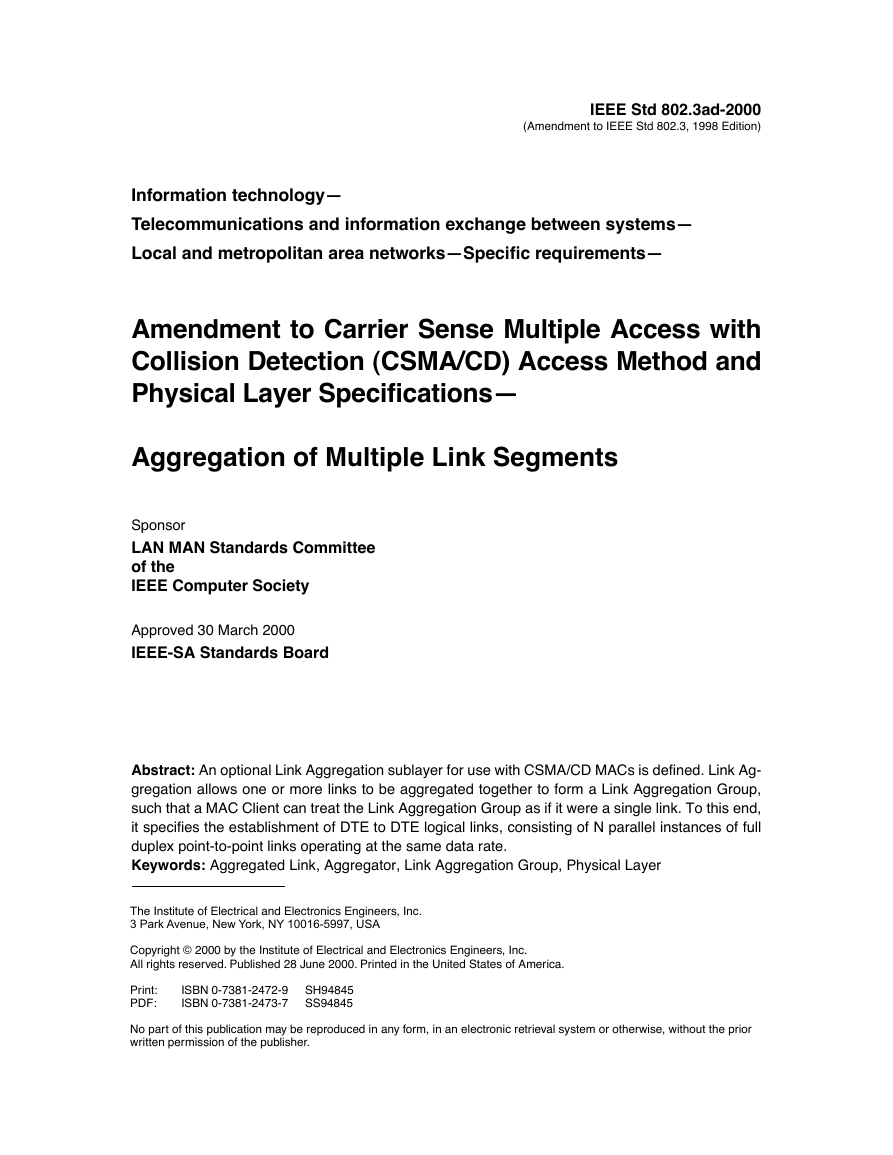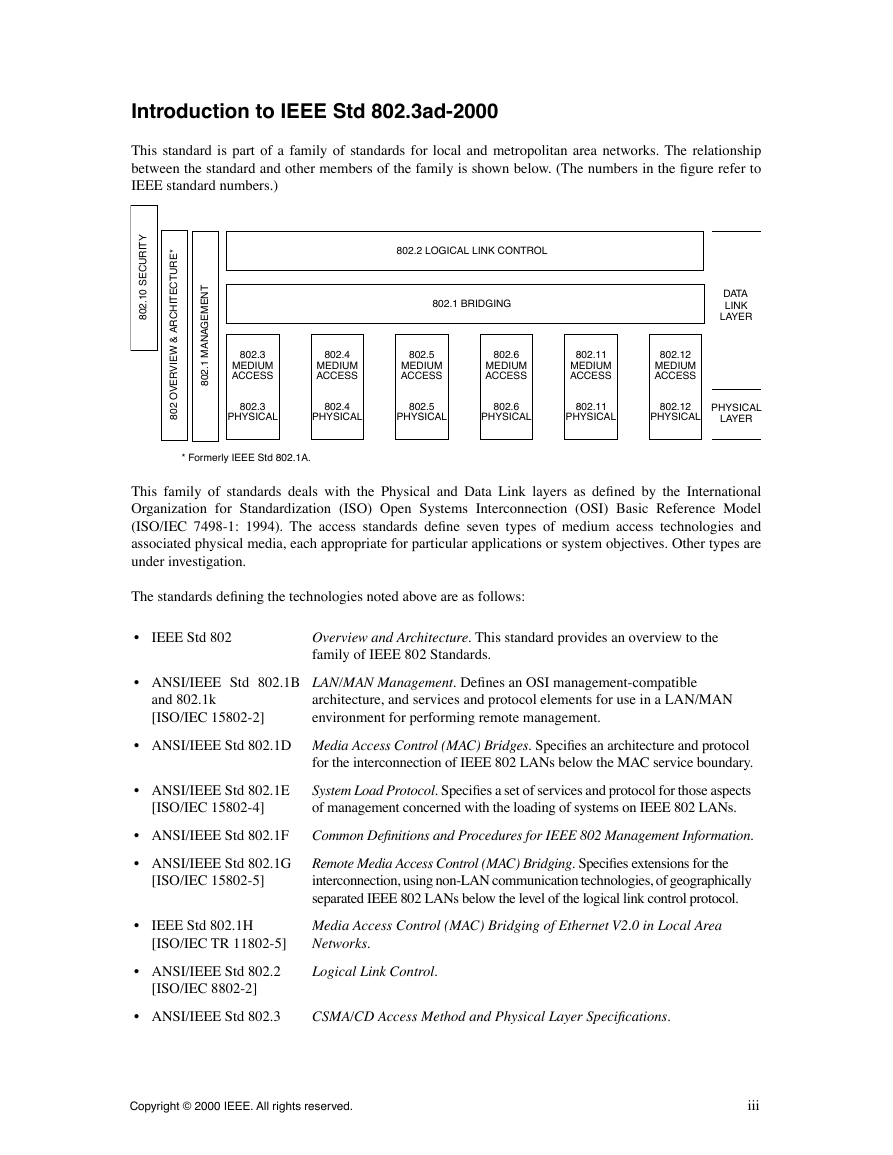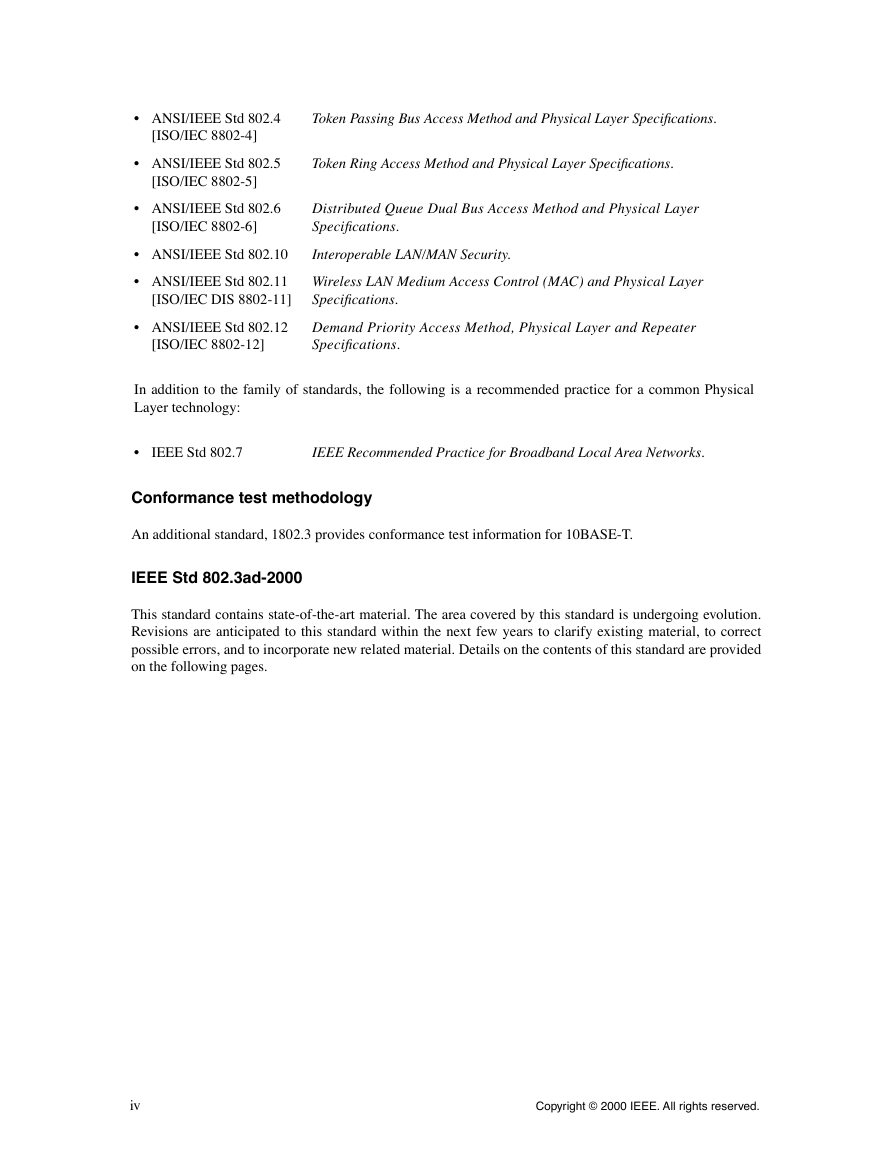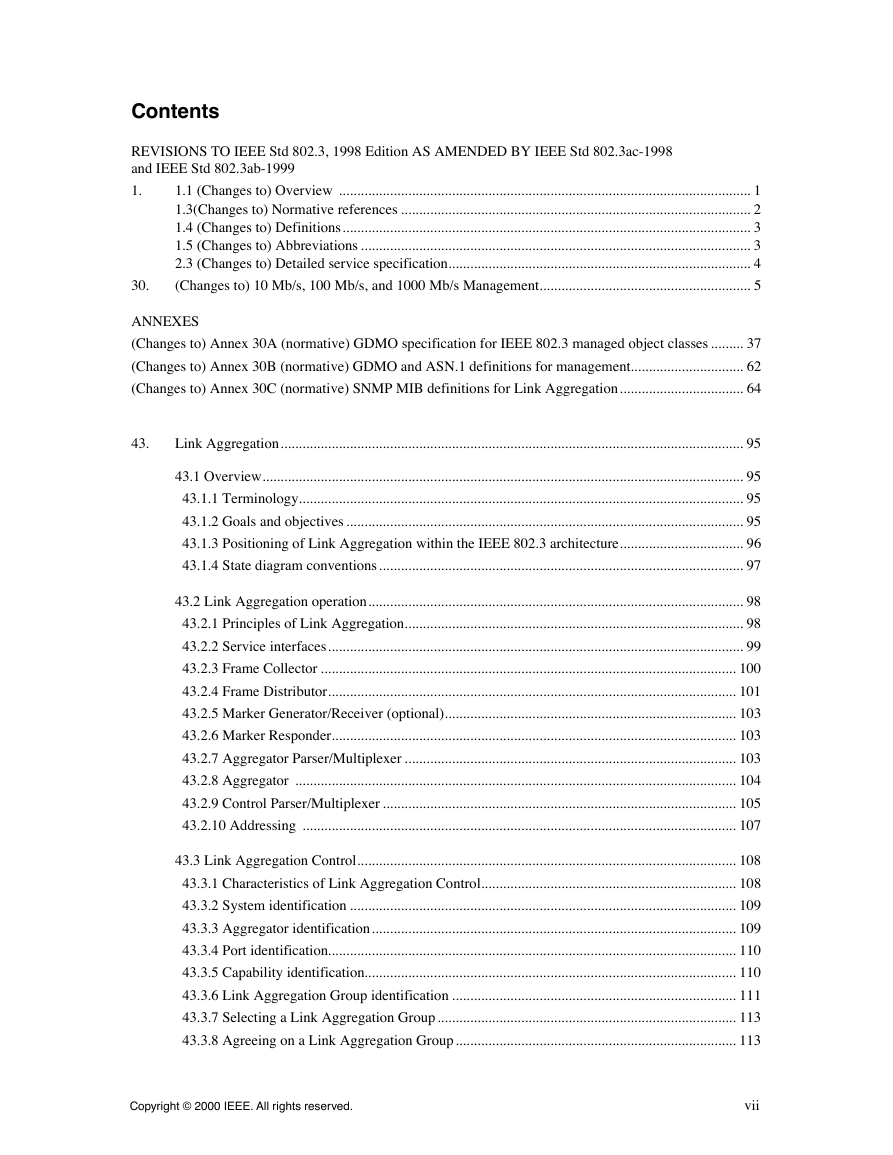Title Page
Introduction
Participants
CONTENTS
CHANGES TO IEEE 802.3, 1998 EDITION
1.1 Overview
1.3 Normative references
1.4 Definitions
1.4.xxx Actor
1.4.xxx Aggregation Key
1.4.xxx Aggregation Link
1.4.xxx Aggregation Port
1.4.xxx Aggregation System
1.4.xxx Conversation
1.4.xxx end station
1.4.xxx Link Aggregation Group
1.4.xxx Partner
1.5 Abbreviations
2.3 Detailed service specification
2.3.1 MA_DATA.request
30. 10 Mb/s, 100 Mb/s, and 1000 Mb/s, MAC Control, and Link Aggregation Management
30.2 Managed objects
30.2.3 Containment
30.2.5 Capabilities
30.7 Management for Link Aggregation
30.7.1 Aggregator managed object class
30.7.2 Aggregation Port managed object class
30.7.3 Aggregation Port Statistics managed object class
30.7.4 Aggregation Port Debug Information managed object class
Annex 30A—GDMO specification for IEEE 802.3 managed object classes
Annex 30B—GDMO and ASN.1 definitions for management
Annex 30C—SNMP MIB definitions for Link Aggregation
AGGREGATION OF MULTIPLE LINK SEGMENTS
43. Link Aggregation
43.1 Overview
43.1.1 Terminology
43.1.2 Goals and objectives
43.1.3 Positioning of Link Aggregation within the IEEE 802.3 architecture
43.1.4 State diagram conventions
43.2 Link Aggregation operation
43.2.1 Principles of Link Aggregation
43.2.2 Service interfaces
43.2.3 Frame Collector
43.2.4 Frame Distributor
43.2.5 Marker Generator/Receiver (optional)
43.2.6 Marker Responder
43.2.7 Aggregator Parser/Multiplexer
43.2.8 Aggregator
43.2.9 Control Parser/Multiplexer
43.2.10 Addressing
43.3 Link Aggregation Control
43.3.1 Characteristics of Link Aggregation Control
43.3.2 System identification
43.3.3 Aggregator identification
43.3.4 Port identification
43.3.5 Capability identification
43.3.6 Link Aggregation Group identification
43.3.7 Selecting a Link Aggregation Group
43.3.8 Agreeing on a Link Aggregation Group
43.3.9 Attaching a link to an Aggregator
43.3.10 Signaling readiness to transfer user data
43.3.11 Enabling Collection and Distribution
43.3.12 Monitoring the membership of a Link Aggregation Group
43.3.13 Detaching a link from an Aggregator
43.3.14 Configuration and administrative control of Link Aggregation
43.3.15 Link Aggregation Control state information
43.4 Link Aggregation Control Protocol (LACP)
43.4.1 LACP design elements
43.4.2 LACPDU structure and encoding
43.4.3 LACP state machine overview
43.4.4 Constants
43.4.5 Variables associated with the System
43.4.6 Variables associated with each Aggregator
43.4.7 Variables associated with each port
43.4.8 Variables used for managing the operation of the state machines
43.4.9 Functions
43.4.10 Timers
43.4.11 Messages
43.4.12 Receive machine
43.4.13 Periodic Transmission machine
43.4.14 Selection Logic
43.4.15 Mux machine
43.4.16 Transmit machine
43.4.17 Churn Detection machines
43.5 Marker protocol
43.5.1 Introduction
43.5.2 Sequence of operations
43.5.3 Marker and Marker Response PDU structure and encoding
43.5.4 Protocol definition
43.6 Configuration capabilities and restrictions
43.6.1 Use of system and port priorities
43.6.2 Dynamic allocation of operational Keys
43.6.3 Link Aggregation on shared-medium links
43.6.4 Selection Logic variants
43.7 Protocol Implementation Conformance Statement (PICS) proforma for Clause 43, Aggregation of ...
43.7.1 Introduction
43.7.2 Identification
43.7.3 Major capabilities/options
43.7.4 Frame Collector
43.7.5 Frame Distributor
43.7.6 Marker protocol
43.7.7 Aggregator Parser/Multiplexer
43.7.8 Control Parser/Multiplexer
43.7.9 System identification
43.7.10 Aggregator identification
43.7.11 Port identification
43.7.12 Capability identification
43.7.13 Link Aggregation Group identification
43.7.14 Detaching a link from an Aggregator
43.7.15 LACPDU structure
43.7.16 State machine variables
43.7.17 Receive machine
43.7.18 Periodic Transmission machine
43.7.19 Selection Logic
43.7.20 Mux machine
43.7.21 Transmit machine
43.7.22 Churn Detection machines
43.7.23 Marker protocol
43.7.24 Configuration capabilities and restrictions
43.7.25 Link Aggregation on shared-medium links
Annex 43A—Collection and Distribution functions
Annex 43B—Requirements for support of Slow Protocols
Annex 43C—LACP standby link selection and dynamic Key management
















 2023年江西萍乡中考道德与法治真题及答案.doc
2023年江西萍乡中考道德与法治真题及答案.doc 2012年重庆南川中考生物真题及答案.doc
2012年重庆南川中考生物真题及答案.doc 2013年江西师范大学地理学综合及文艺理论基础考研真题.doc
2013年江西师范大学地理学综合及文艺理论基础考研真题.doc 2020年四川甘孜小升初语文真题及答案I卷.doc
2020年四川甘孜小升初语文真题及答案I卷.doc 2020年注册岩土工程师专业基础考试真题及答案.doc
2020年注册岩土工程师专业基础考试真题及答案.doc 2023-2024学年福建省厦门市九年级上学期数学月考试题及答案.doc
2023-2024学年福建省厦门市九年级上学期数学月考试题及答案.doc 2021-2022学年辽宁省沈阳市大东区九年级上学期语文期末试题及答案.doc
2021-2022学年辽宁省沈阳市大东区九年级上学期语文期末试题及答案.doc 2022-2023学年北京东城区初三第一学期物理期末试卷及答案.doc
2022-2023学年北京东城区初三第一学期物理期末试卷及答案.doc 2018上半年江西教师资格初中地理学科知识与教学能力真题及答案.doc
2018上半年江西教师资格初中地理学科知识与教学能力真题及答案.doc 2012年河北国家公务员申论考试真题及答案-省级.doc
2012年河北国家公务员申论考试真题及答案-省级.doc 2020-2021学年江苏省扬州市江都区邵樊片九年级上学期数学第一次质量检测试题及答案.doc
2020-2021学年江苏省扬州市江都区邵樊片九年级上学期数学第一次质量检测试题及答案.doc 2022下半年黑龙江教师资格证中学综合素质真题及答案.doc
2022下半年黑龙江教师资格证中学综合素质真题及答案.doc